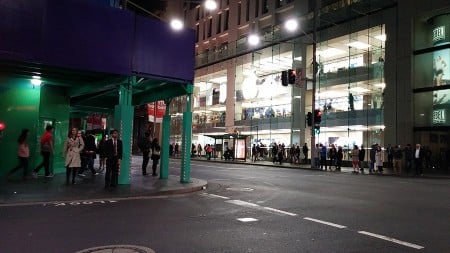On the whole, it’s a very easy overlay to get used to, and LG has even left some of our favourite features from previous models, such as the ability to change app icons easily, support for more than four icons in the shortcut dock (and you can change these), pulling and pinching in gestures to either show an entire photo or show all of your homescreens, soft-buttons that can be re-ordered, and the knock features such as the ability to tap on the screen to switch the phone on, and even use the “knock code” which is a security code based on tapping the screen a set amount of times.
You’ll also find a drop down menu, as per typical Android, but with LG’s modifications applied, with a degree of transparency, modern flat icons based on line art, and a remote controller for your TV and amp built into this section.
A smart widget also pays close attention to what you’re doing, monitoring your activities in a way similar to what Google’s Now does, reminding you of things in everyday English, such as if you need to bring an umbrella with you because it might rain, or if you should charge your battery.
It’s like having an assistant that doesn’t talk, because if you don’t need a virtual talking friend, you can have one in text that sits underneath your clock and weather monitor.
And there’s even a dose of that dual-screen app action, something Samsung first introduced in its handsets that allows you to run two apps side-by-side, or in this case, on top of each other.
Gmail with web browsing? Done. Maps and messaging? Done. On the G3, simply hold the back button down to begin, and your last session will also be saved in case you want to bring it back to life in a jiffy.
Using the phone is more or less the same as it ever has been, so we won’t get into that, but sufficed to say, you can still make phone calls, and send messages, and do all the things you would normally do on a phone.
Performance is decent, and thanks to high-end specs, it’s pretty strong across the board, though there is some lag, which we’ll get into later on.
From a benchmark point of view, the G3 matches the competition, and that shouldn’t be surprising since there’s pretty much the same technology inside.
Mobile performance is also very strong, and if you’re on a network with support for Category 4 LTE connectivity, this is helped with download speeds of up to 150Mbps.
Our Telstra tests in Sydney aren’t supported by Cat 4 just yet, but we managed speeds of between 19 and 80Mbps, which puts the G3 on par with just about all the other major smartphones coming out, so you should have decent downloads where ever you go in Australia.
The camera is also very important, and for this side of things, there hasn’t been just a recycled camera.
Don’t get us wrong, LG’s cameras haven’t been bad in the past, but we’re excited to see some different technology make the transition to LG’s G3 handset.
As such, you’ll find a 13 megapixel with a truly futuristic sounding “laser auto-focus.”
What’s that, you might be asking?
Rather than just work off contrast detection, the G3’s camera will fire off a laser looking for things to focus on, working with the contrast detection to acquire focus quickly. In lots of light, the laser won’t probably do much, but in low light, a laser could be beneficial for a speedy shot, making it a neat inclusion altogether.
Using the camera is easy enough, mind you: simply touch the screen and the auto-focus points will pop up, generally firing the shot after focus has been acquired. You can, if you like, use a button on the back of the handset, and for that either of the volume buttons on the back will do, with both volume up and volume down firing the shot off.














